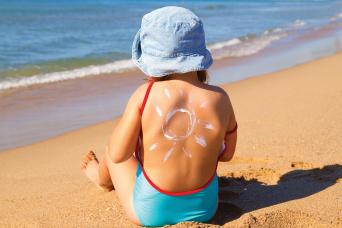
The Health & Wellness Committee Says: Before You Chill Out, Cover Up and Slather Up
Views expressed in this article are those of the author, not necessarily the Health & Wellness Committee, and are not a substitute for talking to your doctor.
Now that summer has finally arrived, it is good to be thinking of protecting our body’s largest organ — the skin. Damage from the sun’s ultraviolet rays can cause skin cancer, but it can be prevented by taking proper precautions.
Before we get to slathering on sunscreen, here are a few simple rules that you may find helpful:
- Cover the skin with loose-fitting clothing such as long-sleeved shirts and long pants.
- Don’t forget hats and sunglasses to protect the eyes.
- Wear a rash guard when swimming.
- Remember when you are at the beach or pool that water and sand reflect UV rays more strongly.
- Try to avoid the sun during the middle of the day because the rays are at their strongest during that time.
- Stay hydrated to prevent heat stress, and limit strenuous exercise to 15 minutes if heat and humidity are high. Warning signs of overheating are dizziness, nausea and feeling light-headed. Water is sufficient; sports drinks are only recommended after strenuous exercise.
Know your product
There are many products that offer sun protection, including zinc- and titanium-based sunscreens — so-called mineral sunscreens — and “chemical” sunscreens, which usually contain some combination of avobenzone, homosalate, octinoxate, octisalate, octocrylene and oxybenzone. (There is controversy about whether oxybenzone is dangerous to humans by causing hormone disruption. The U.S. Food and Drug Administration has deemed it safe, but the American Academy of Pediatrics recommends avoiding it if possible.)
In general, an SPF rating higher than 50 is not necessary and may give you a false sense of security. Choose a broad-spectrum sunscreen that works against both UVA and UVB rays. It is important to apply sunscreen early (at least 15 minutes prior to exposure) and often (every 2 hours). The recommended amount is about 1 ounce per young adult.
Children are at special risk for sunburn. They are more vulnerable to the damaging effects of the sun’s rays.
When putting sunscreen on small children, avoid aerosols, since they can get inhaled (and usually do not end up being applied in sufficient quantities anyway).
Infants under the age of 6 months, even when protected by loose-fitting clothing, should be kept out of the sun as much as possible. Use small amounts of sunscreen if necessary. A wide-brimmed hat that also shades the neck should be used to prevent sunburn, and look for infant-sized sunglasses to protect their eyes — and then try to keep them on!
Also be aware that infants and children cannot regulate their body temperature in the same ways as adults and are more at risk for heat stress. How do you know whether an infant or child is sufficiently hydrated? The average person voids about 5 times a day, infants up to 8. If you notice a decrease in urine output or the urine is dark yellow in color, it is time to increase the fluid intake.
Hope you enjoy your summer and keep in mind that any sunscreen is better than none!
Connie Winkler, MD, FAAP, is a hospital-based pediatrician who works at Abington-Jefferson Health. Email her at winklerca1@gmail.com.

